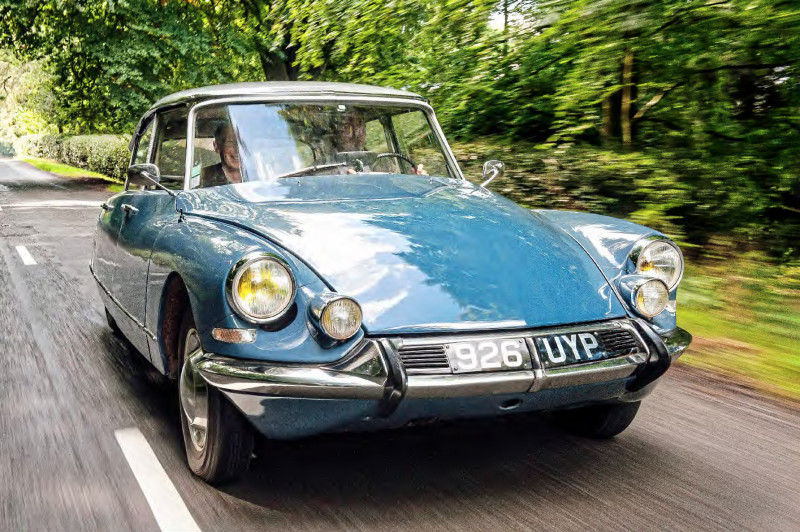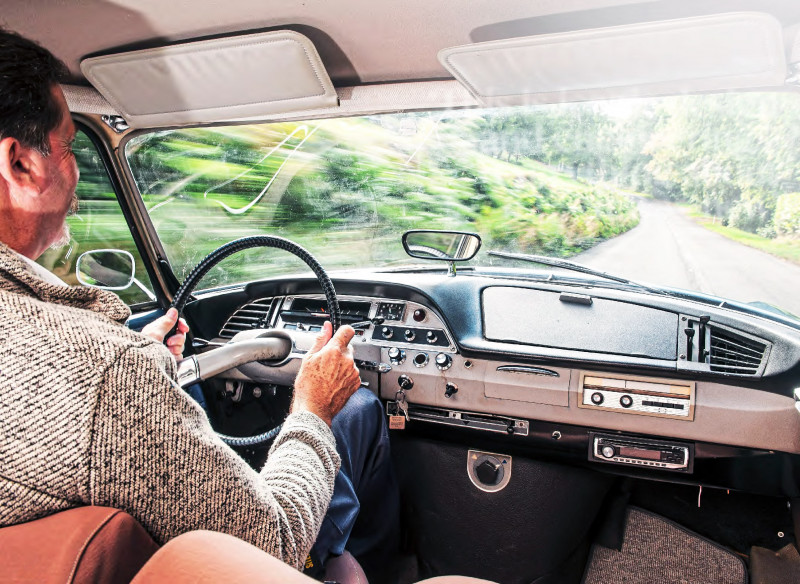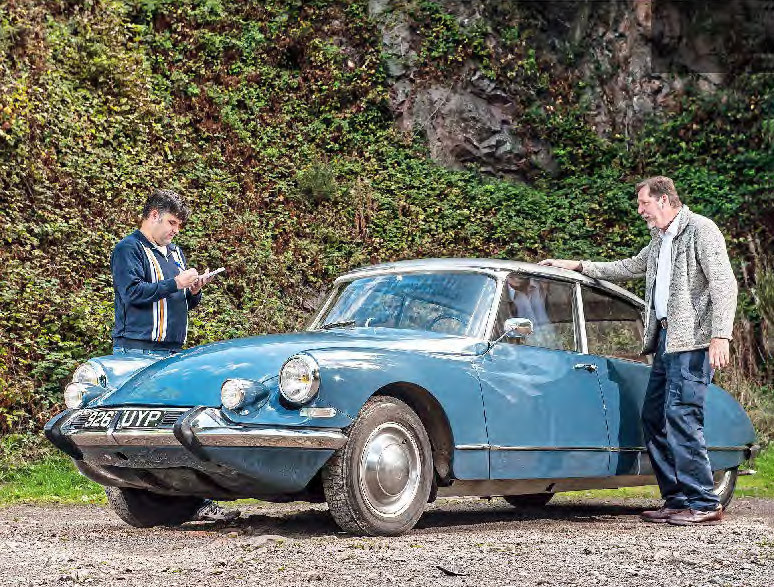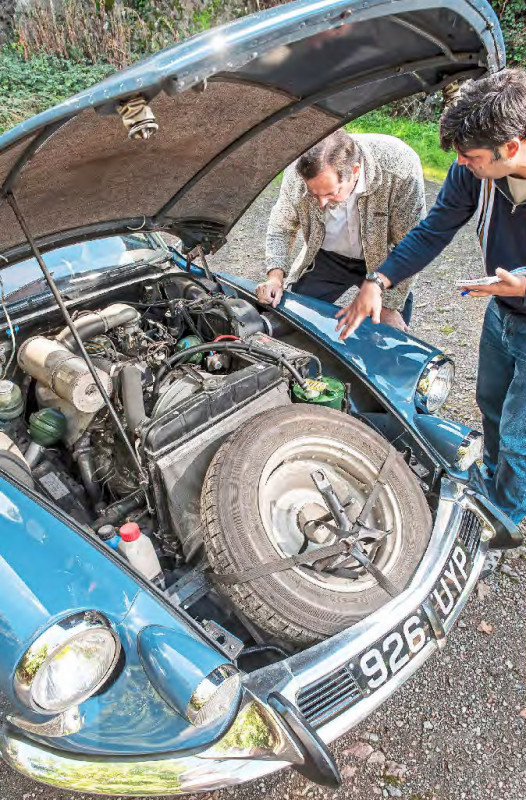1962 Citroën DS19
Classic Cars reader Simon Biggs is a connoisseur of classic luxury saloons, so how will he find the pure early Citroën DS19 – and at 6ft 6in, will he fit in it?
Words SAM DAWSON
Photography LAURENS PARSONS
The List Reader Simon Biggs adds to his unusual saloon experience with a Citroën DS19
This is iconic design and engineering – everything about it was new’
‘It has a soundscape unlike any other’ — an artist meets his DS muse
Simon Biggs lives up to his name. He pulls up in a woodland car park in his modern BMW, having enjoyed the roads around Malvern – home of Morgan – and clambers out to examine the Citroën DS19 he’s come from Birmingham to drive. At six feet six inches tall, he towers over the French Sixties classic.

After pacing around the car, he politely admits something to me. ‘Much as I’ve been looking forward to driving the Citroën DS, I did wonder whether I was going to fit in it,’ he says. ‘When I went shopping for a classic, I went round shows asking owners of cars I liked whether I could sit in them, and ended up having to cross most of them off my list. I hope I won’t have this problem with the Citroën.’ After a full circuit of the car, he reaches the driver’s door and looks through the frameless glass. ‘Ah good, it’s an automatic,’ he says. ‘I haven’t driven a manual in years!’

Simon and Sam examine the DS’s defining hydraulics ‘I will get used to the brake pedal. I owe it to the car’
It’s at this point that the DS’s owner, Frank Sibly, does the introduction. Big Citroëns are like no other car, and as I have found myself, the uninitiated need a translator versed in their foibles in order to understand them. Simon gets settled in the deeply-padded, sofa-like drivers’ seat. ‘There’s more room than expected in here,’ he notes as he slides his knees under the single-spoke steering wheel. Looking at the pedals, though, prompts confusion. ‘Which one’s the brake?’

‘I will get used to the brake pedal. I owe it to the car’
Frank gives Simon a sudden immersion in DS driving technique, ‘The pedal on the left that looks like a clutch is actually the parking brake, but it’s also the emergency brake,’ he explains. ‘If the hydropneumatics fail, it’s the last thing to go, so it’ll bring the car to a halt, but hopefully you won’t need to use that today.’ Frank points out the column-mounted gear lever. ‘Rather than being fully automatic, it’s a sequential semiautomatic,’ he explains. ‘The movement of the lever between ratios actually activates the clutch. Be warned though, it is possible to shift straight from first gear to reverse – so don’t do that! The brakes? They’re controlled by that button on the floor. You don’t stamp on it, just squeeze it gently with your foot. If you stamp on it, it’ll stand the car on its nose.’

Simon sits quietly in the driver’s seat, taking it all on board. Frank has actually prepared a laminated card on the dashboard with a series of reminders about the DS’s various alien ways. Simon thinks about it all for a few minutes, then turns the ignition key, but even starting the DS isn’t straightforward. Initially sat squat to the ground, the hydraulic circuits pressurise and the car begins to rise. ‘The back end comes up before the front, and pressurisation takes up to one minute – don’t drive off before it’s fully off the ground,’ says Frank. ‘It’d make a rubbish getaway car, wouldn’t it?’ quips Simon. We all jump in as Simon makes his first DS-borne foray into the Malvern Hills.
‘I’m glad this road is clear, because to be honest it’s quite difficult to drive,’ he admits. ‘I’ve spent 40 years driving sat on the right-hand side of the car, with the pedals in a different arrangement. And the brakes are very sharp,’ he notes, as an early attempt to lightly brush them in anticipation of a tightening bend results in an ungainly lurch forward. ‘You just touch that button and the car stops.
‘However,’ he says after a moment of contemplation, ‘I have size 13 feet, so maybe it’s about just learning to be gentle. And there is so much more to recommend about this car already. The accelerator is nicely responsive, the steering is very sensitive, and the ride… it’s very soft, as are the seats. Some might call this particular combination lollopy if they weren’t being nuanced about it, but in reality it’s all just so smooth.’
Simon thinks about how the DS compares to his own classic, a Jaguar S-type of the same era. Import taxes from France made the DS as expensive as the Jaguar back in the Sixties, so anyone in the market for a luxury saloon at the time might have had both on their test-drive lists. But does technology trump traditionalism? ‘Compared to my Jag, it’s much softer to drive,’ says Simon. ‘The hydraulics give this incredible floating sensation, in every direction, unexpectedly. You move backwards, forwards, up and down without this sense of being in harsh physical contact with the road at all. The Jaguar is smooth, true, but it’s not perfect – this would have been otherworldly by comparison at the time. It still is.’
Simon pulls the DS19 up at a vantage point looking out towards Hereford and the Welsh border, immediately regretting his forcefulness with the brake pedal as the car lurches heavily to a halt. ‘It takes a lot of getting used to,’ admits owner Frank from the back seat. ‘In fact, on some British-built DSs and IDs, they put a conventionally-hinged pendant pedal over the top of the floor button so British drivers weren’t so bamboozled by it, but it still had a very urgent action regardless, thanks to the pressurised hydraulics involved.’
Simon muses on cultural differences as he surveys the DS, sat alone like an alien landing craft in a quintessentially British landscape. ‘It is very Gallic,’ he remarks. ‘I don’t precisely know what that means to be honest, but there is something about the Citroën DS; it’s a car that only the French could create. It’s very different from driving any English car.
‘Maybe it’s the French approach to design that does it. When you look at the DS, it’s just so different. Not one bit of it is conventional, from the suspension to the design of its steering wheel. When the British experimented with ideas like this, we ended up with the Austin Maxi, which wasn’t a bad car, but it isn’t an iconic piece of design and engineering the way this Citroën is. The Maxi’s shape was all about function, yet when you look at the DS, whilst it’s also functional in terms of aerodynamics, it’s also beautiful. I mean, just look at those high-level rear indicator lights. They’re there for visibility, but they’re integrated so elegantly in a way that other countries’ car industries just don’t think about.
‘Funnily enough, it was things like this which led me to putting another French car – the Facel- Vega HK500 – on my List. It too has incredible, idiosyncratic details, like the meticulously hand-painted imitation wood dashboard. But there must be a reason for that, and it’s understanding that reasoning that’s the key to learning the car.’ He climbs back in the DS’s driver’s seat with a renewed sense of enthusiasm, staring down the brake pedal as he does so. ‘I will get used to it,’ he emphasises. ‘I owe it to the car.’
We continue on the deserted country lanes, out towards Worcester. Simon’s confidence in the car is growing now, as he explores the way it corners at B-road speeds. ‘I love driving probably too fast, if I’m honest, and came down these roads on the way here in my BMW,’ he admits. ‘I like a car that really picks itself up and moves. This, however, is a car for Sunday driving. Something you take out with a destination in mind but no sense of hurry. ‘If I’m honest I think I’d prefer to be in my S-type on these roads. The DS moves around a lot in the bends. Pitch it into a corner and you can feel it move side-to-side quite noticeably. I suspect it would be rather easy to get it to oversteer.
‘But I have to keep reminding myself that this is my problem, not the car’s. Driving a Citroën DS can make you realise just how unused you are to driving properly smoothly, and getting into its rhythm rather than trying to force it into your own. But I’m enjoying the experience more and more. It’s incredible how a design that’s 67 years old can adapt to different road surfaces better than my brand-new BMW, but it does – I barely noticed how bumpy the road was in this.
‘You learn how to make smoother progress too. You need to lift off the throttle when you change gear to make it properly seamless, but that becomes a game in itself, which results in being a better driver. I appreciate its little details better as I drive it too. At first I thought the tracking was out when I saw the steering wheel’s single spoke off at an angle, but it’s for safety, to avoid being impaled on it in a crash. The turning circle is much tighter than expected, despite having front driveshafts, and I can tell the all-round visibility is excellent although it’s wasted on me because my head is against the roof. But again, that’s my problem, not the car’s.’
Simon pulls into a car park on the outskirts of Worcester, intrigued to discover more about the technology behind all this smoothness. ‘I am very interested to see what’s under the bonnet,’ he says, as the nautically-shaped nose of the DS springs skyward. ‘This has to be the hydraulic fluid circuit,’ says Simon, pointing at the mass of tanks, tubes and spheres nestled around the engine. ‘It’s fascinating. I must admit, when I knew I’d be driving the DS, I downloaded two articles about it because I didn’t want to turn up not knowing how it worked. These spheres, for example, are half-gas, half-liquid, with a rubber membrane between the two. I was a science teacher, and this car appeals to my science background.
‘But I’m also an artist – I have paintings exhibited in Wolverhampton Art Gallery – and this car also appeals to me as a work of art,’ says Simon as he settles into the back seats for a different perspective on DS life. ‘It possesses a whole different soundscape, one of hisses, rumbles, clicks and whines. You know you’re in a DS simply by closing your eyes and listening. ‘And look at this door card. It’s got aluminium, vinyl, four different mediums and patterns. It’s not like any other car’s door card. It genuinely is a piece of abstract mixed-media artwork. You could frame it and exhibit it as a piece of modern art.’
‘Is it still in my top ten? Well, yes, but in a different, unexpected way. I would have one – probably a DS23 rather than a 19 because I think it needs more power – but as a piece of art. I’d own it to look at, to sit in and appreciate, and be seen in – I’d employ a chauffeur, so I could waft through France to Monte Carlo, appreciating the car and the landscape while someone else drove it as smoothly as possible.’
Simon is 6ft 6in tall, but DS is ‘as comfy as my sofa at home’
TECHNICAL DATA 1962 Citroën DS19
- Engine 1911cc in-line four-cylinder, ohv, Zenith double-choke carburettor
- Max Power 90bhp @ 5250rpm
- Max Torque 110lb ft @ 3000rpm
- Transmission Four-speed clutchless sequential manual, front-wheel drive
- Steering Power-assisted rack and pinion
- Suspension Front: independent, leading arms, anti-roll bar, hydropneumatic spheres. Rear: independent, trailing arms, anti-roll bar, hydropneumatics spheres
- Brakes Discs front, drums rear, hydraulically-assisted
- Performance
- Top speed: 87mph
- 0-60mph: 23.3sec
- Weight 1232kg
- Fuel consumption 21mpg
- Cost new £1726
- Classic Cars Price Guide £7k-£21k
Simon and Sam examine the DS’s defining Hydraulics.
SIMON’S DREAM DRIVE LIST
Facel-Vega HK500
‘An iconic French car, and not an obvious one either. An international effort too, with its American engine’
Bentley Mark VI
‘I love big, British luxury saloons. This was probably the best of its kind when it was new.’
Citroën DS
‘The all-time great icon of car design. So different, so original.’
Bristol 401
‘Another piece of very intelligent, aerodynamic postwar design.’ Ford Sierra Cosworth RS500 ‘I love driving at a fair old lick, and have had BMWs from the RS500’s era. But it was always the fastest thing in its class – Ferrari performance in a Ford Sierra.’
Bentley Continental S2
‘I love Jaguar Mk2s and own an S-type – this represented the ultimate in British luxury when those Jags were new.’
Jensen 541
‘Another pioneering piece of design – a glassfibre-bodied 100mph four-seater.’
BMW 3.0 CSL E9
‘I tend towards appreciating a driving environment as important as well as comfort. This seemed to be designed around the driver.’
Ferrari 212
‘I’ve always wondered what it’d be like to drive something so overtly race-bred on the road, and go back to the early days of Ferrari.’
Aston Martin DB5
‘Serious power and luxury, and a British icon.’
SIMON’S CAR CV
VANDEN PLAS PRINCESS
‘As a broke trainee teacher, I scraped together £200 for it. An odd choice for a first car but my Uncle Derek recommended it. Oddly enough the bank would give me a £700 car loan to replace it, but not £250 to fix the gearbox! Swapped it for a Ford Cortina MkIII – and changed the gearbox in that myself!’
MINI
‘I actually found this very comfortable, with plenty of leg- and headroom. I bombed around in it for ages.’
MORRIS MARINA 1300 COUPÉ
‘Bought for £600 from my mother-in-law. I was in a band called The Bee’s Knees at the time, and used to drive to gigs in it.’
BMW E28 5 SERIES
‘I used to flash up and down motorways in this, but repair costs got too high in the end. I sold it for £1000 and instantly regretted it. The girl who bought it from me didn’t get the engine serviced and blew it up.’
JAGUAR S-TYPE
‘After sampling several classics, I fell in love with the Jaguar Mk2 but couldn’t afford one. Then a Jaguar enthusiast pointed out that the S-type looked similar, drove better, had more room in it and cost less. What’s the catch, I asked? There isn’t one. Well, unless you need to get it restored…’
MERLIN TF AND +2
‘These were kit cars, and unusually for sports cars, seemed designed around the taller driver, with scooped-out floors. The +2 had more seat adjustability too. Great fun.’
Even rare factory radio is a modernist masterpiece Unusual DS pedals take a lot of getting used to.
Iconic singlespoke wheel is actually a safety and visibility aid


